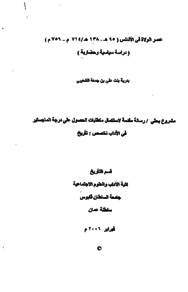Document
عصر الولاة في الأندلس(90 هـ - 138 هـ / 714 م - 756 م)
Other titles
دراسة سياسية و حضارية
Publisher
جامعة السلطان قابوس
Gregorian
2006
Language
Arabic
Subject
English abstract
This study has Intended to highlight the Wulat (Governors) Period in al-Andalus and the serious associated events which have formed the bases on which the Islamic and Arabic Culture has been built in al-Andalus. This study has concentrated on the following elements:
1. Demographic elements in al-Andalus at that time and the relationships between those elements.
2. The most important political events and cultural achievements of the Muslims during that period.
The researcher has used an analytic conclusive study style thru a very an efficient and careful readings which lead to new conclusions. This study is divided to an introduction, preference, 4 section and a conclusion as follows: Preference has covered the conquer of al-Andalus by the Arab Muslim, the Preference of that conquer and the main events associated with it. Section I has analyzed the demographic elements in al-Andalus at that time and the relationships between those elements. Section 2 has Illustrated each of the Governors (Wulat ) during the period ( 95 -138 A.H)-(714–756 A.D), the most important achievements and events during the period of each Governor (Wulat). Section 3 covers al-Andalus during the political transition from Umayyad State to Abbasl State. In this section the researcher has concentrated on two points; firstly, the period of Governor Yousuf bin Abdl-Rahman al-fahri, secondly the invasion of Abdul-Rahman bin Muawiyah al-Amawi to AL-Andalus and becomes a new Governor. Section 4 has analyzed some of the culturel achievement in al-Andalus, for instance, the administrative, cultural and literary during that period.
The researcher have collected may of her conclusions at thened of this study. The most important conclusion is that the Arab Muslims they were carriers of a humanitarian message of Islam which introduced that part of the world to the great Islamic culture.
There are statistical differences at the level of significance (a = 0.05) among the averages of the students of the experimental group and the control group in the retention application of the geometry achievement test due to the use of the interactive board.
In the light of the researcher findings of results, she suggests some of recommendations and proposals including: The need to support and encourage the process of employing modern technologies in education, to provide students, teachers and educational supervisors with training courses, in order to raise their awareness with the importance of using the interactive board as a methodology, and how to choose and apply it in education, and studying the impact of interactive board on other variables such as visual thinking.
Member of
Resource URL
Arabic abstract
عنيت هذه الدراسة بعصر الولاة بالأندلس وما رافق هذا العصر من أحداث جسام شكلت الأساس الذي قامت عليه الحضارة الإسلامية العربية في الأندلس ، وقد ركزت هذه الدراسة على الجوانب التالية : ١-العناصر السكانية للمجتمع الأندلسي خلال هذه الفترة ، وطبيعة العلاقة بين هذه العناصر ۲-أهم الأحداث السياسية و الإنجازات الحضارية للمسلمين خلال فترة عصر الولاة .
انتهجت الباحثة في كتابة هذا البحث المنهج الاستقرائي الإستنتاجي ، وذلك من أجل قراءة النصوص قراءة دقيقة متفحصة لتعطي آراء واستنتاجات جديدة . احتوت الدراسة على مقدمة وتمهيد وأربعة فصول وخاتمة وجاءت على النحو التالي :
تناول التمهيد عملية الفتح والمراحل التي مرت بها وأهم الأحداث التي رافقت عملية الفتح ، وقد تناول الفصل الأول عناصر السكان في الأندلس خلال عصر الولاة وطبيعة العلاقة بين هذه العناصر ، أما الفصل الثاني فقد استعرض ولاة الأندلس خلال الفترة ( ۹۰ ه - ۱۳۸ ه ۷۱۶ م - ۷۰۹ م) وأهم الأعمال التي قام بها كل والي والأحداث الهامة التي شهدها عهده . وقد تحدث الفصل الثالث عن الأندلس و فترة الانتقال من سقوط الخلافة الأموية وقيام الخلافة العباسية ، وركز على نقطتين أساسيتين هما ولاية يوسف بن عبد الرحمن الفهري ، ودخول عبد الرحمن بن معاوية الأموي الأندلس وسيطرته على الحكم فيها .أما الفصل الرابع فقد عرض بعض الجوانب الحضارية كالنواحي الإدارية والثقافية والأدبية في عصر الولاة . توصلت الباحثة إلى نتائج عديدة عرضتها في الخاتمة من أهمها أن المسلمين الفاتحين كانوا حملة رسالة وهي نشر الدين الإسلامي والثقافة والعلم والحضارة الإسلامية .
انتهجت الباحثة في كتابة هذا البحث المنهج الاستقرائي الإستنتاجي ، وذلك من أجل قراءة النصوص قراءة دقيقة متفحصة لتعطي آراء واستنتاجات جديدة . احتوت الدراسة على مقدمة وتمهيد وأربعة فصول وخاتمة وجاءت على النحو التالي :
تناول التمهيد عملية الفتح والمراحل التي مرت بها وأهم الأحداث التي رافقت عملية الفتح ، وقد تناول الفصل الأول عناصر السكان في الأندلس خلال عصر الولاة وطبيعة العلاقة بين هذه العناصر ، أما الفصل الثاني فقد استعرض ولاة الأندلس خلال الفترة ( ۹۰ ه - ۱۳۸ ه ۷۱۶ م - ۷۰۹ م) وأهم الأعمال التي قام بها كل والي والأحداث الهامة التي شهدها عهده . وقد تحدث الفصل الثالث عن الأندلس و فترة الانتقال من سقوط الخلافة الأموية وقيام الخلافة العباسية ، وركز على نقطتين أساسيتين هما ولاية يوسف بن عبد الرحمن الفهري ، ودخول عبد الرحمن بن معاوية الأموي الأندلس وسيطرته على الحكم فيها .أما الفصل الرابع فقد عرض بعض الجوانب الحضارية كالنواحي الإدارية والثقافية والأدبية في عصر الولاة . توصلت الباحثة إلى نتائج عديدة عرضتها في الخاتمة من أهمها أن المسلمين الفاتحين كانوا حملة رسالة وهي نشر الدين الإسلامي والثقافة والعلم والحضارة الإسلامية .
Category
Theses and Dissertations

